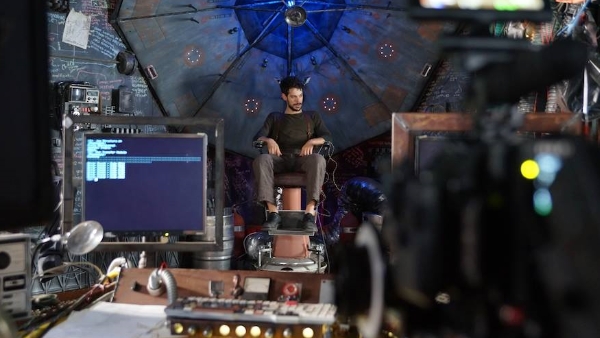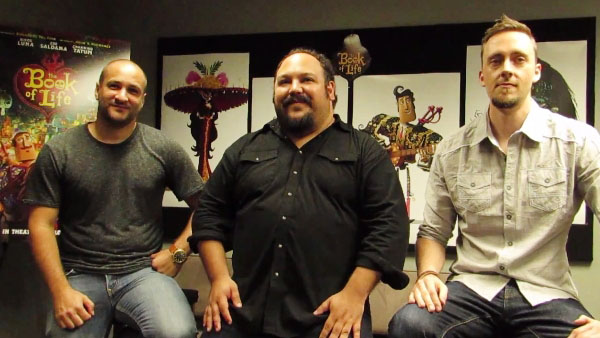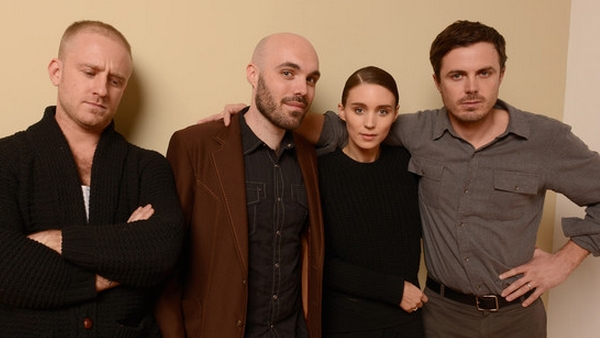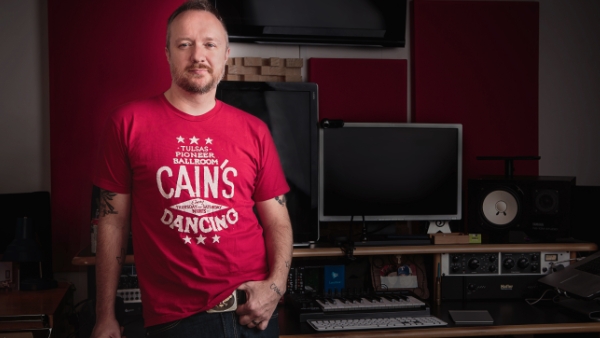 Local filmmaker, Derek Presley, is a great friend of the site, and we’re always excited to help spread the word about his latest projects. Filmed here in DFW, and featuring contributions of a number of area trades persons, Cronus was filmed and produced over the course of two years. It’s a film about a genius recluse with amnesia who awakens to find he has built a machine that extracts memories from the dead. He uses those memories to discover who he is and to rebuild a perfect past for himself.
Local filmmaker, Derek Presley, is a great friend of the site, and we’re always excited to help spread the word about his latest projects. Filmed here in DFW, and featuring contributions of a number of area trades persons, Cronus was filmed and produced over the course of two years. It’s a film about a genius recluse with amnesia who awakens to find he has built a machine that extracts memories from the dead. He uses those memories to discover who he is and to rebuild a perfect past for himself.
The practical effects, the music and the production design (not to mention acting from Joey Folsom and Ted Ferguson) are all very strong and make the film seem far grander than the limited budget would allow. But Derek does a much better way of explaining what’s on screen and why, so enjoy this interview with our highly creative friend.
Cronus is interesting on many levels and is very much in the same vein your other projects. It’s an interesting concept, and the delightful combination of witty, wacky, adds to this handmade feature. Much of your past work focuses on dreams and memories, but where did this all start, and what kind of research did you do?
Derek Presley: It’s a combination of three things, but the foundation comes from a family member of mine who went through dementia. It sounds disturbing to say it was intriguing to think about, but really I wanted to see if there was a way to create a machine that would capture memories. I wanted to know what would happen if we recorded our memories and get to experience things we have forgotten or want to revisit.
The second is from a friend and collaborator of mine, Brandon Schwindt who co-wrote Cronus along with Cody Berry, who did a very romantic short film called September Bird, which is about a doctor who has a machine that can record memories from someone’s DNA and allows you to watch them on a screen. The last was basically “what could we do on a minimal budget?”, and I’m always a fan of the “genius recluse” movies which are almost a genre in and of itself. So I dragged Laura McQuay into this to produce and we set out to make this weird little film.
Darren Aronofsky’s Pi was a big inspiration for me, as was Shane Carruth’s Primer for different reasons. Altered States was another one as well. But we talked to a lot of people about this, and did research to see how you could even attempt to pull this off. We read books, and got a lot off of Google, but we found that if a person’s brain was damaged, you could, technically, if you stave off the mortises and the brain could survive – just like if you threw a computer out a window, you could save some of the hard drive.
So this is based on a science that is somewhat possible today?
Yeah. There are scientists in San Diego who are able to remove memory from a mouse and put it back into its brain. They did it through flashes, somehow, and I don’t know how it worked, but they were able to make one mouse navigate a maze that it had no prior exposure to.
You are a die-hard Terry Gilliam fan, and like his films, you too have some fun in the face of otherwise dour societal settings.
True, this is a bit of fantasy, and you can tell that I don’t take myself too seriously. We took this film in a comical direction which, I don’t know if that’s good or bad, is what we stuck to, and we really felt like we were doing something unique. In something like Total Recall, for instance, you’re dealing with the possibility of manipulated memories built for one person. But through our main characters we attempt to piece this technology together, he created a collage of memories he was able to assemble as his own because he had no memory of himself or his past.
This was ambitious, and although we only saw things through the eyes of a very few characters, you made reference to lots of important dramatic things that were just on the periphery of the lens. What did you have to strip away to get what we saw on screen?
Well we had written ten versions of the story, but they were all too grand. No one was going to back me financially, and I knew I wasn’t ready as a filmmaker to handle anything like that yet. So we had to think about how to make a movie for cheap, but it had to be something that kept moving and changing.
It couldn’t be about two guys who find a dead body in a house and have to keep it covered up for two hours. I don’t have the patience or skill to do something that focused, so I feel I work better when there’s a lot going on. [Laughs] I feel like I have A.D.D.
But we put all our money on the production, and all the post was very economical, which is stressful because people are working so hard on something that there is no financial reward…only to say you did it. Johnny Fegan was our editor and he took on the job of twenty people and he did it as if he were an artist painting, which he is actually, so it was natural for him.
Trust me, the tangibility of things really telegraph’s through the screen. I like how practical your sets and effects are. The Mnemosyne machine was incredible – you just wouldn’t expect to see that care taken to a small film, but you really thrive off of those small details.
On a personal level, I didn’t want too much CGI. Even if I had the money, I wouldn’t have wanted very much of it because it takes you away from the story. When I watch films, I just drool over set design, and when I see something I know very well is not there, it takes me out of the movie. There are so many good things CGI is used for, but even in big budget films I feel it distances you.
But on Cronus, Johnny Fagan was our visual effects guy as well, and he did so much great work. Most of it was to cover our mistakes because we were shooting very fast and we didn’t have a lot of money. We story boarded most everything, and M.J. Marcinik (cinematographer) and I were very particular about the framing, but there were some things that we just couldn’t take care of. So Johnny did an amazing job with little things you’d never notice but they helped out so much.
On another note, as far as the practical side of things, we could have easily done this in a garage or house in a suburban setting, but I had the idea that I didn’t want to see any trace of society. I wanted it far removed from anything recognizable. You could get a sense of history, and that these memories occurred in the past, but you have no way of knowing where Cronus or anyone else are in this dilapidated future. We weren’t going for a Mad Max, post-apocalyptic future, I just referred to it is an “economic apocalypse,” and we set the film in three distinct visual frames.
The first is the warehouse laboratory which is a kaleidoscope of different images and colors, then we made sure the memories were very vivid and punchy, and then there was the real world which was dreary and de-saturated.
I know it was made here in Texas, but where specifically was this shot?
Laura McQuay was amazing at finding this abandoned helium plant which was the first and only helium plant in Fort Worth. She went to Oklahoma and Denton and god only knows where else and she found this perfect place in our backyard. It was used during war time in the first half of the 1900s, and then after many years it became a location for SWAT teams to do training and maneuvers. It’s a bleak, uniquely beautiful place to be in. You feel removed from anywhere else in the world.
We did 5 months of story boarding, and by the time we were about to start shooting, we found that the place was sold to a guy who does haunted houses, and he was about to start staging this for his venue. But we ended up becoming friends with the owner, and he let us use the facility while he was getting all the construction done.
While it wasn’t the best arrangement for us, it worked out because he said, when we get done, he would like to keep everything intact. So it’s kind of cool that if you go to Hangman’s House of Horrors in Fort Worth, you will see the memory machine because they didn’t have time to move it out. [Laughs] He thought I was going to get mad because I couldn’t keep it, but my response was “hey, are you kidding me? I don’t live in a mansion. Where am I going to put it??” So we had a good laugh, and it’s been another amazing experience in this tumultuous profession.
Well I have to say that the machine looked like a million bucks even if I wouldn’t want to touch the thing.
Thanks. That goes back to Pi and how we wanted everything to be really gritty. No clean screens allowed! [Laughs] And it worked, or at least it looked like it did.
Well that the funny part because it was either myself, or producer, Tex Thayer sitting under the machine typing up text whenever Cronus was inputting into the computer. Tex created the program – the code is legit and not just random keystrokes. The coolest thing is that one of our costumers, Adam Taggart, does coding at his job. I told him I wanted “jibber-jabber,” [Laughs] you know, just random symbols to printed out on dot matrix printing paper, but he went home and really coded something that is based on a particular function for us, printed it up and brought it to set and looks great on screen.
Funny story: one time I got chewed out by Tex because I missed a space on the code, and he was like, “you missed the space, that code is not going to work,” so I said, “chill out, Lex Luthor, we’re making a movie!” [Laughs] All of that helped flesh out this world, even on a cheap budget. And it was a complete team effort down from Laura McQuay and her determination to find a perfect location, to Chris Barkett with his amazing work on the machine, and the performances from the cast. I was lucky to have that team, that is for sure.
The only time we get an idea of a place and time that is alludes to what you call the “economic apocalypse” is when Ogg talks about The Governor cracking down on people. So it’s neat that you hint at something – like a faction of people who have risen up – but you never give too much to the audience. What did you, and what did you not want to develop for the sake of focusing on this small story?
There’s a lot that we didn’t get to put in, and the original draft was 112 pages. It got cut down to 85 when we started shooting. We have entire subplots that we had to jettison. One was about these people called “Messengers” who work for this man named Prophet Tartauruas, and he’s linked to The Governor.
We had the idea that whenever Cronus left the facility he saw tons of banners for the prophet, but in a way I kind of got mega-churchy. We wanted to have fun with everyone but without being mean to anyone. I really wanted to lift a scene from one of my favorite movies, The City of Lost Children. We even had all the story boards, but we couldn’t do it.
So you have two dynamic and polar opposites with Cronus and Ogg, but then there’s Thanatos. Did I miss a few Gods in my Greek and Roman mythology class?
[Laughs] First, I have to say that Ted Ferguson is just plain awesome. He’s doing stuff left and right and I’ve worked with him since my first short, The Keymaker. We shot this in Texas, but we give almost no hint that we are in the Metroplex.
I tried really hard so we didn’t give anything away as to geography, I didn’t even want trees to be seen. When it came to naming people, that was my way of not letting anyone know, similarly, where this was taking place. We wanted the names to be different but also have a little bit of meaning and be clever little nods we could make to the audience.
Cronus is derivative of Chronos, the father of time, and our character doesn’t have any time. Thanatos is father of peaceful death, and in our film he is robbed of a peaceful death and lives out an existence not knowing who he is in a horrible, horrible little hospital. O *click* double G was two things: fan boy love for Time Bandits that had a character called Ogg, and second, it’s the King of the Giants in the Old Testament.
The idea that Ogg exists is to play the Igor to Cronus’ Frankenstein in a way, but that’s just superficial. He was necessary because I felt like you would have trouble staring at one guy for the entirety of a film. A single character/genius worked with Pi, and other films because the story is smaller and you get out of his tiny apartment in New York as well. But this needed something different to keep it intriguing because it’s literally 80% inside his lab.
Joey is fantastic, and I could watch him for a whole movie. He has a sort of Clark Gable coolness to his delivery.
I totally agree! But we felt we need to give the audience a breath of fresh air via some insanely weird comedic relief. That’s where Tom Zembrod comes in. He’s amazing in my opinion. He not only does a great job with his character, but he’s also a producer who did countless jobs on set from designing to assistant directing to being a soundboard.
I can’t even imagine finishing the film the way we did without him. With his character of Ogg – people who’ve seen the film, and are over the age of 40, tend to not understand Ogg. And the younger people like Ogg a lot. He’s over the top, and he’s supposed to be. I grew up on Looney Tunes, so that sums up why Ogg is the way he is.
But the characters are at the forefront of the story, but besides their names, there’s lots of things we put in to be subliminal references. For instance we have gears and circles everywhere because Cronus is basically going in circles until he finds a state of normalcy with all this patchwork of stolen memories. It’s kind of a fun way of letting the audience know he’s going to be stuck in the same place doing the same thing again and again only with different elements. The other half of it is that he deserves it – he’s not a good person.
Thanks to Derek for his time. You can check out his profile on IMDb by clicking this link. Cronus will begin its festival run (which will also be the world premiere) at Phoenix ComicCon on May 26. The Con runs May 25 – 28.


